Isotopes of Uranium. The naturally-occuring and artificial isotopes, which have to be considered in the fuel cycle of all commercial light water reactors, are summarized here. Material Properties
Isotopes of Uranium
The main isotopes, which have to be considered in the fuel cycle of all commercial light water reactors, are:Naturally-occurring isotopes
- 238U. 238U belongs to the group of fertile isotopes. 238U decays via alpha decay to 234Th with half-life of ~4.5×109 years. 238U occasionally decays by spontaneous fission with probability of 0.000055%. Its specific activity is very low ~3.4×10-7 Ci/g.
- 235U. 235U belongs to the group of fissile isotopes. In fact, 235U is the only existing fissile nucleus from naturally-occurring isotopes and therefore it is a highly strategic material. 235U decays via alpha decay (by way of thorium-231) into 231Pa with half-life of ~7×108 years. 235U occasionally decays by spontaneous fission with very low probability of 0.0000000072%. Its specific activity is very low ~2.2×10-6 Ci/g.
- 234U. 234U belongs to the group of fertile isotopes. 234U decays via alpha decay to 230Th with half-life of 246 000 years. 234U occasionally decays by spontaneous fission with very low probability of 0.0000000017%. Its specific activity is much higher ~0.0063 Ci/g.
Artificial isotopes
- 233U. 233U belongs to the group of fissile isotopes. It is produced by neutron radiative capture in nuclear reactors containing thorium fuel. 233U decays via alpha decay into 229Th with half-life of 159 200 years. 233U occasionally decays by spontaneous fission with very low probability of 0.000000006%. Its specific activity is ~0.0098 Ci/g.
- 236U. 236U is neither a fissile isotope, nor a fertile isotope. 236U is fissionable only by fast neutrons. Isotope 236U is formed in a nuclear reactor from fissile isotope 235U. 236U decays via alpha decay to 232Th with half-life of ~2.3×107 years. 236U occasionally decays by spontaneous fission with very low probability of 0.00000009%. Its specific activity is ~6.5×10-5 Ci/g.
- 232U. 232U belongs to the group of fertile isotopes. 232U is a side product in the thorium fuel cycle and also this isotope is a decay product of 236Pu in the uranium fuel. 232U decays via alpha decay to 228Th with half-life of 68.9 years. 232U very rarely decays by spontaneous fission. Its specific activity is very high ~22 Ci/g and its decay chain produces very penetrating gamma rays.
Comparison of total fission cross-section and cross-section for radiative capture.
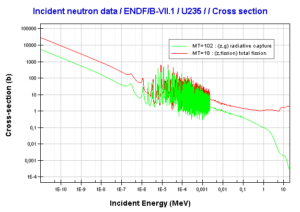 Uranium 235. Comparison of total fission cross-section and cross-section for radiative capture.
Uranium 235. Comparison of total fission cross-section and cross-section for radiative capture.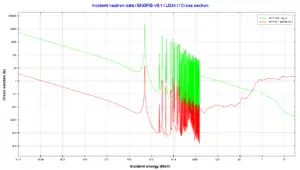 Uranium 234. Comparison of total fission cross-section and cross-section for radiative capture.
Uranium 234. Comparison of total fission cross-section and cross-section for radiative capture.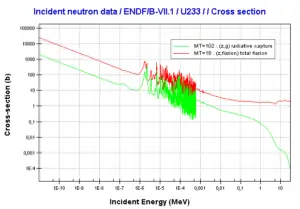 Uranium 233. Comparison of total fission cross-section and cross-section for radiative capture.
Uranium 233. Comparison of total fission cross-section and cross-section for radiative capture.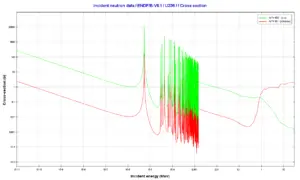 Uranium 236. Comparison of total fission cross-section and cross-section for radiative capture.
Uranium 236. Comparison of total fission cross-section and cross-section for radiative capture.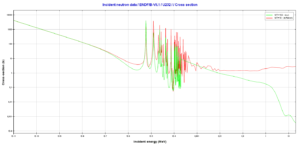 Uranium 232. Comparison of total fission cross-section and cross-section for radiative capture.
Uranium 232. Comparison of total fission cross-section and cross-section for radiative capture.
Source: JANIS (Java-based Nuclear Data Information Software); The JEFF-3.1.1 Nuclear Data Library Uranium 238. Comparison of total fission cross-section and cross-section for radiative capture.
Uranium 238. Comparison of total fission cross-section and cross-section for radiative capture.
 Uranium 235. Comparison of total fission cross-section and cross-section for radiative capture.
Uranium 235. Comparison of total fission cross-section and cross-section for radiative capture. Uranium 234. Comparison of total fission cross-section and cross-section for radiative capture.
Uranium 234. Comparison of total fission cross-section and cross-section for radiative capture. Uranium 233. Comparison of total fission cross-section and cross-section for radiative capture.
Uranium 233. Comparison of total fission cross-section and cross-section for radiative capture. Uranium 236. Comparison of total fission cross-section and cross-section for radiative capture.
Uranium 236. Comparison of total fission cross-section and cross-section for radiative capture. Uranium 232. Comparison of total fission cross-section and cross-section for radiative capture.
Uranium 232. Comparison of total fission cross-section and cross-section for radiative capture.We hope, this article, Isotopes of Uranium, helps you. If so, give us a like in the sidebar. Main purpose of this website is to help the public to learn some interesting and important information about materials and their properties.